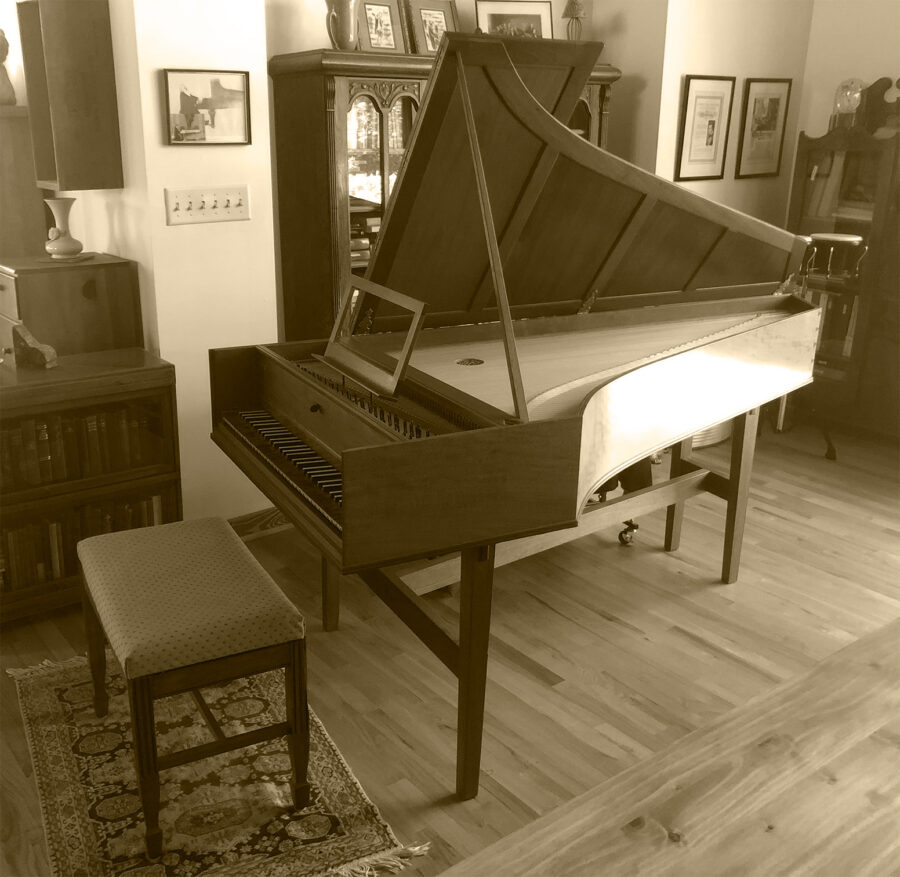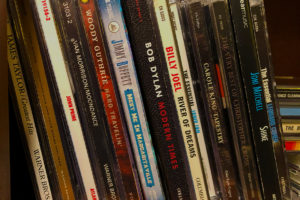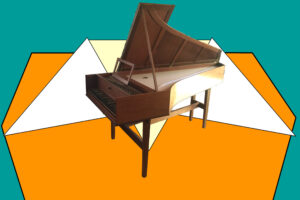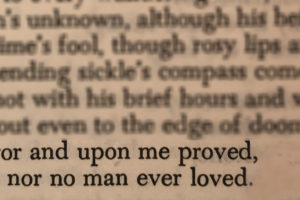Several years ago, much to my surprise, I realized that I have been hearing the harpsichord in literally hundreds of songs on the radio and in recordings for years. Why have I never noticed that? I decided to research the use of harpsichord in popular music.
The harpsichord is a keyboard instrument in which the strings are plucked rather than struck with a hammer like a piano. The plucked strings have a rich, clear sound. In some ways the sound resembles a guitar. And, similarly, arpeggiated figures are often used. However, the keyboard lends itself to a different style of arpeggiation than a guitar.
Generally, the harpsichord has two or more sets of strings, each producing different tone qualities. They can also have something called a lute or buff stop—a lever presses pieces of soft leather against one of the sets of unison strings, producing a muted, pizzicato tone.
The harpsichord was invented during the late Middle Ages and was the prominent keyboard instrument during the Renaissance and Baroque eras. When the fortepiano was invented in the mid-eighteenth century, since it could play loud and soft dynamics, the harpsichord was not used as much and fell out of favor.
The harpsichord had a resurgence in the twentieth century. This involved not only performances of old music—there was new music composed for the instrument—especially composers with a Neoclassical bent, such as Francis Poulenc and Manuel de Falla. Prominent performers in the revival of the harpsichord were Wanda Landowska, Sylvia Marlowe, Gustav Leonhardt, and E. Power Biggs.
I am not sure who was the first to introduce the harpsichord into music beyond classical music, but Sylvia Marlowe often played on the radio and was one of the first to perform jazz and rock music on the harpsichord. In the 1940s she appeared at the Blue Angel nightclub in New York. She became so well known and respected that when Benny Carter’s sextet, featuring Dizzy Gillespie, gave its first concert at the Metropolitan Museum of Art on November 5, 1941, Marlowe was also there playing her “Harpsichord Blues and Boogie Woogie.”
The harpsichord can pierce through a wall of instruments or add a certain ping-quality in the background. Its unique sound conjures up impressions of courtly times. This makes sense for those wanting a different, unusual instrument, especially during the 1960s Baroque Pop period.
The harpsichord is one of my favorite instruments. In 1983, my husband and I commissioned a harpsichord builder to make a French style harpsichord. In May 1983, for our wedding, we chose recorders and harpsichord as instruments played at our wedding rather than the organ. One of our dear college professors brought his harpsichord and played.
I have compiled a list of popular music that uses the harpsichord. I am sure there are more, but these are the ones I have found through research and listening. In this blog I will list music from the 1940s and 1950s. I will cover the following decades in my next blogs.
Use of the Harpsichord in the 1940s
The earliest mention of the harpsichord I could find in popular culture or music is a mention in the 1940 movie, Second Chorus. There’s a funny moment when college-oriented student, Fred Astaire makes an academic joke about a dissertation and the topic is “the future of the harpsichord in swing music.” The movie centers around clarinetist Artie Shaw and his orchestra. And, in the fall of 1940 Artie makes this idea come to life with a series of recordings using harpsichord.
As John Guarnieri told “Piano Jazz” radio host Marian McPartland in 1981, he was already in Shaw’s big band when Shaw called him one day in the fall of 1940:
“Shaw asked me if I’d ever played the harpsichord, and I said: ‘Certainly.’ And he said, ‘Well that’s great; we’re gonna make some records tomorrow.’ . . . I was lying! So I said, ‘Artie—I don’t know what a harpsichord is.’ . . . He says, ‘I have one up the house; let’s go up there tonight—and we’ll rehearse, and we’ll make some records tomorrow.’”
The pianist got the hang of the antique instrument (with its stiffer keyboard action) pretty fast, he told a writer from Time-Life records in 1973: “I went home and practiced until I could trill with the fourth and fifth fingers for twenty seconds, then I was okay.”
Artie Shaw and His Gramercy Five
“Summit Ridge Drive” (1940) is one of his most endearing hits — a masterpiece of small-combo jazz. It is named after the canyon street where he lived in the Hollywood Hills. Artie Shaw & His Gramercy Five put the song together in an hour jam session rehearsal. With a winning combination of clarinet, trumpet, and harpsichord the track became a classic. John Guarnieri is playing harpsichord and played harpsichord on all these tracks from 1940. The harpsichord is prominently featured in these tracks.
“Cross Your Heart” (1940)
“Special Delivery Stomp” (1940)
“Smoke Gets in Your Eyes” (1940) The buff stop is used in the opening of this track.
Sylvia Marlowe
“Honky Tonk Train” (1940)
“Pine Top’s Boogie Woogie” (1940)
“Yancey Special” (1940)
Use of the Harpsichord in the 1950s
The greatest surge for the harpsichord came in 1951 when Mitch Miller, head of the record division at Columbia, enlisted Stan Freeman to play the harpsichord on Rosemary Clooney’s hit “Come On’A My House.” Miller came from a classical background and loved novel instrumentation. He would do anything to grab the listener’s attention. It was his idea to use the harpsichord on Percy Faith’s “Delicado” and on several other Clooney records.
Jamies, The
“Summertime, Summertime” (1958) was one of the first popular songs to use the harpsichord. The song is upbeat and fun. It reminds me of an English madrigal with the vocal harmonies and use of the harpsichord.
Percy Faith and His Orchestra
“Delicado” (1952) is from the album, Delicado. The album contains a collection of rhythms from south of the border. Stan Freeman is playing harpsichord. Freeman studied classical piano in college earning a bachelor of music degree from the University of Hartford in 1942. His technical proficiency is evident. He makes full use of the range of the harpsichord.
Rosemary Clooney
“Come On-A My House” (1951) was written by Ross Bagdasarian (AKA David Seville) and his cousin, the Armenian American Pulitzer Prize winning author William Saroyan. They wrote it in the summer of 1939, while driving across New Mexico. The melody is based on an Armenian folk song. Clooney recorded the song with Mitch Miller and his orchestra and harpsichordist Stan Freeman.
“Mambo Italiano” (1955) was written by Bob Merrill in 1954 for Rosemary Clooney. It reached the Top Ten in record charts in the US and France and No. 1 in the UK Singles Chart in early 1955. Merrill wrote it hastily on a napkin in an Italian restaurant in New York City and then used the pay phone to dictate the melody, rhythm, and lyrics to the studio pianist. The song is an obvious parody of genuine mambo music.
Rosemary Clooney and Marlene Dietrich
“Dot’s Nice – Donna Fight!” (1952) Stan Freeman is playing harpsichord.
“Land, Sea and Air” (1952) Stan Freeman is playing harpsichord.
“Too Old to Cut the Mustard” (1952) Stan Freeman is playing harpsichord.
Stan Freeman
“Perdido” (1951) is a jazz instrumental with harpsichord.
Use of the Harpsichord in the 1960s
In the 1960s a genre or style developed that was called Baroque Pop or Baroque Rock. It combined rock music with elements of classical music—such as contrapuntal melodies and functional harmony patterns. Harpsichords figured prominently as well as oboes, French horns and string quartets. A slightly later development is referred to as psychedelic Baroque pop.
In my next blog, “Use of Harpsichord in Popular Music: Part 2,” I will go into more detail about the use of the harpsichord in the 1960s.
Do you know other songs from the 1940s and 50s that use harpsichord? List them in the comments below!










6 Comments
Leave your reply.